
Here in North Florida we had the traditional "in like a lion, out like a lamb" March. The month began with freezing temperatures that left the Cypress Pond covered with a skin of ice (see last month's Journal). It quickly warmed up though, and near perfect weather greeted spring's official arrival. The last season freeze nipped some blossoms and postponed the azaleas' annual flower show for a few days, but by mid-month they resumed painting the town in a pastels frenzy. By the end of the month the temps were hitting record highs and I was considering a visit to Wakulla Springs for an early season swim - what a difference a month makes!
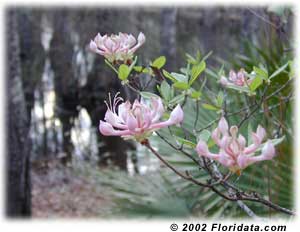
I inherited dozens of Southern Indica and native deciduous azaleas when I bought my place. They were planted by the previous owner, a nice southern lady named Miss Nell who had a talent for combining colors and siting plants. Along the driveway she had planted more than 75 flowering dogwoods (Cornus florida). For a couple of weeks each March they transform into a hazy clouds that gently shower white petals upon the sandy drive (OK, they're actually bracts but petal sounds more romantic). Where the drive loops, she underplanted a grove of long leaf pines (Pinus palustris) with dogwoods and beneath these dozens of 'Purple Formosa' Indicas that have grown into an 8' high wall of magenta blossoms. Encircling the Cypress Pond, on the opposite side of the drive, is a mixed border of white 'Mrs. G. G. Gerbing', a 'Red Formosa', more 'Purple Formosas', and several pink varieties of whose names I'm unsure. I've also preserved one her wisterias (I keep it pruned into a small tree) whose fabulously fragrant, beautiful blue flowers reflect with a sizzle upon the black pond water.
Over the years I've added to Miss Nell's creation adding southern magnolias (Magnolia grandiflora), sabal palm (Sabal palmetto) and blue palm (Sabal minor). I've thinned much of the scrubby stuff and trimmed up the huge clumps of native saw palmetto (Serenoa repens). The plants are maturing and the Cypress Pond was at its prettiest this March - I think this is the look Miss Nell had in mind.
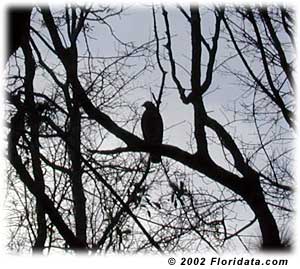
Wildlife at Floridune
The Cypress Pond is looking so cool that a pair of red tailed hawks has taken up residence at the top of a tupelo tree (although our large population of tasty squirrels may have influenced the decision some too). We have an ongoing plague of squirrels here who thrive on stolen dog and duck food. They are fat and lazy with too much free time on their hands that that gives them too much time for romance which leads to large families which leads to a problem for me. The result is periodic population explosions when gangs marauding squirrels eat everything: flower buds, bamboo shoots, attic insulation, my house, etc. So while I don't like them, they are much appreciated by hawks as nutritious snackfoods. I'm looking forward to a great summer because I'll get to watch a family of baby hawks grow into adulthood sustained by fat succulent squirrels. All month I've watched Mr. and Mrs. Hawk transporting huge sticks to the tree top and arranging them into a substantial nest - now to wait for the blessed event!
In Bloom at Floridune
Here in North Florida, March belongs to the azaleas for they are everywhere and they are spectacular. If you can manage to pull your gaze away from the azalea color show, though, your eyes will be soothed by the white haze of dogwood that floats serenely above the landscape. Whether lined up like soldiers along the driveway or in scattered cloud formations in the forest, by the third week in March our native dogwood was at its brilliant best. Unfortunately the driveway dogwoods showed signs of the discoloration caused by the fungus epidemic attacking the species in the southeastern US. Happily those trees in shadier locations had a nice crop of pure white blossoms for me to enjoy and photograph. The experts predict that our flowering dogwood will go extinct in its native area - I hope some resistant varieties are identified before that happens because I can't imagine spring without this outstanding favorite.

One of my newest favorite plants, Scabiosa columbaria 'Butterfly Blue' resumed blooming in March. A freeze in late January killed back the tops and I worried they might not return. My fears quickly disappeared when new leaves a few days later and the plants rapidly recovered. By the end of the month, the scabs are covered with dozens of blue blossoms that will continue to burst forth well into the dog days of summer. Here in my garden they cope with heat, humidity, drought and occasional dog pee attacks until mid-August when they collapse into exhausted heaps. After a few weeks of rest and cooler temperatures, the 'Butterfly Blues' return once again to bloom like crazy until halted by a freeze. I read somewhere that if you deadhead (remove the dead flowers) they will bloom non-stop until frost - I'm lazy so I'd rather give up a few weeks of flowers in exchange for the ease of ignoring their maintenance!
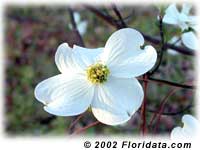
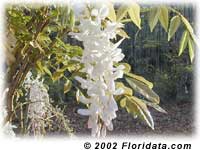
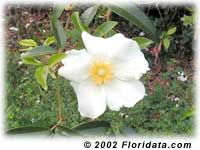

Many other species bloom in March as well but we're less likely to see them than the feel them! Many species of oak, pine, holly and others are blooming and dispersing huge clouds of pollen. Each grain patiently waits it turn to fly up my nose for the fun of sending me into fits of sneezing, coughing and cursing. I'll be relieved when these flowers fade!
My Good Buds<
The hard freeze that struck at the beginning of the month came as a shocking surprise for us. Overnight the color riot of Southern Indica varieties was subdued and the landscape suddenly reverted to more peace loving greens and earth tones. My attention no longer bound by the assertive azaleas, I began to notice the more subtle beauty of awakening leaf buds. Evergreen or deciduous, each has its own special strategies for bursting forth and transforming into mature foliage.
Late one afternoon while surveying the freeze damage I spied the bright green leaf buds of a small sassafras tree. Spot lit by the setting sunlight the buds stood tall and erect at the terminus of each branch as if for optimal ornamentation. I admired the tree's Dr. Seuss-ish asymmetry as the sun set in the west, each bud a glowing golden-green jewel. Enchanted by the budding beauties I grabbed the camera and dashed about taking pictures, determined to get them all before dark which I didn't... The next evening I returned to photograph the species that I missed the day before. Leaf bud are fast growers though with a beauty even more transient than flowers, changing form, size and color dramatically within a short period of time - which of course it another reason they're interesting. I recommend that you pull your attention away from the flowery springtime showoffs for just a minute and enjoy the subtle beauty of the buds.

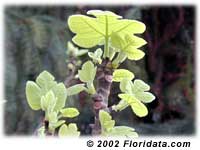
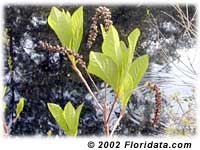
Projects
As usual, Floridata projects hogged up most of my free time in March but I did manage to get a few things done in the garden. This is the best time to plant, transplant and propagate before the weather gets too hot and the odds for success diminish.
For the past four years I've been gradually planting an area up on the hill with some favorite perennials and culinary herbs. There's a creeping rosemary (Rosemarinus officinalis) that's not getting enough sun so he moved to be near a trio of other rosemary varieties. They are growing well there so the creepy one should thrive too. Just down the path and beneath a Natchez crape myrtle (Lagerstroemia indica) is where I grow most of my other herbs. I just planted a new lemon thyme (Thymus vulgaris) alongside a French thyme and others that have grown into small woody shrubs planted among some lime rocks. The thyme looks pretty scrambling over the boulders but more importantly lime rock raises the pH of our acidic soil making it more to the liking of thyme. Another woody stemmed small bushy plant is garden sage (). I had several thriving in this area until last spring when they passed on. Sage is a short-lived perennial in this climate and I expect to replace them every 2 or 3 years. On the other hand the oregano (Origanum vulgare)just keeps on coming! I have a variety called 'Compactum' that forms low green carpet of foliage that I hack back a few times each year to keep it from overwhelming the rest of the herb patch. Unfortunately 'Compactum' is not very flavorful so I put in some Greek oregano which is similar in appearance but is tastier (fresh leaves on hot pizza - yum).
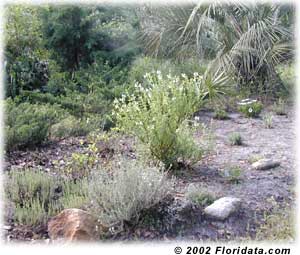
Another pretty low grower is the uplifting herb, St. John's wort (Hypericum perforatum). Two summers ago I had one that grew into a dinner plate size spot of dense ground hugging stems until a big stupid puppy stepped on it. It got funky with fungus and died. My new Saint is puppy-proofed with guardian rocks to prevent any depressing accidents.
I'm also growing two other herbs that I've never tried before. Lemon balm (Melissa officinalis) is an herb I've had many times in herbal tea but have never grown. I hope it does well here because it has attractive foliage whose ice tea enhancing properties I admire. Spanish lavender (Lavandula stoechas) is my other newcomer. I pessimistically expect it to be attacked by fungus and to succumb to July's heat and humidity but hopefully I'll get a few fragrant flowers from it first. Whatever happens hopefully I can keep them healthy long enough to get pictures of them for Floridata.
The most unpleasant job of the month was trimming the pampas grass. This stuff is wicked! By late winter the huge 8'-10' flower plumes are frayed and worn and a thatch of dead leaves is accumulated around the base. Some like to burn off the clumps to remove the dead leaves and kill the pests that live within. This works best if the leaves have died and dried out during the winter. Mine are all near other plants so I don't like to burn, instead trimming them with a hedge shears. Another consideration is that the leaves remained green and fresh due to last winter being mild so burning would have been slow and smoky.
Whether dry or fresh, the leaves of the pampas grass are weapons of destruction that swiftly slice, saw, slit and infect human skin at the slightest provocation. As if going into battle, I donned protective gear including long sleeve sweat shirt, gloves and a baseball cap to keep the fierce foliage from my face. Sweating profusely I whacked and hacked and attacked the 10' high clumps with the ferocity and determination of a religious warrior. Within twenty minutes the clumps were conquered standing transformed into neat 6' gumdrop mounds, ready once again to burst into fountains of fresh foliage and huge plumes of feathery flowers come mid-summer. But the battle did not leave me unscathed. The saw-teeth leaf edges unfortunately left inflamed cuts on my neck and chin and they somehow penetrated the sweatshirt sleeves to mark my forearms with angry red abrasions. Even so I think I got off easy - nothing a blob of antibiotic ointment can't cure!
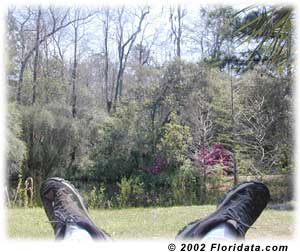
The Lawn Chair
Whenever possible, I crash into my lawnchair by the Catfish Pond and stare vacantly into space. This is called "planning" and it's when I try to figure out what to do next with Floridata. Here is the "to do" list of what I hope to accomplish by the end of the year:
- More Articles! Look for several new contributors in the coming weeks with articles on shade gardening, roses and garden tours!
- New Plant Profiles! Steve and I are hard at work on more than 20 new additions to the plant encyclopedia including edibles, bedding plants, trees and shrubs.
- New Updates to Existing Plant Profiles! Some of our earliest Profiles are over five years old so I've upgrading them with lots of new photos and information. I'm also adding Warnings to indicate invasive or otherwise problematic species.
- New Look and Navigation! There will be more attractive and efficient menus and simpler navigation for the site that will make it faster and easier to use. We're also planning new plant lists (like Salt Tolerant plants) and a more comprehensive search facility.
Thanks for your suggestions, corrections and comments because they are very helpful and encouraging. Visit Floridata often this spring and always be good and grow!
John S. "Jack" Scheper 4/19/02